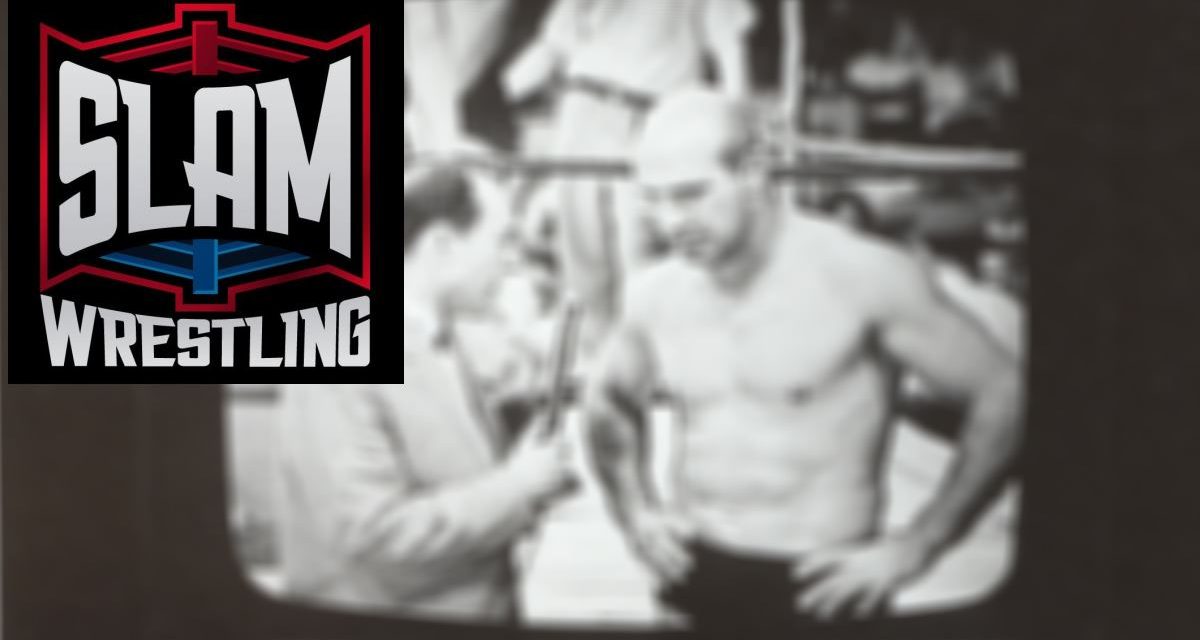They called him the “Man of 1,000 Faces” but he could have just as easily been known as the “Man of 1,000 Miles” as journeyman wrestler Lee Henning traveled extensively for over 35 years throughout the mat world.
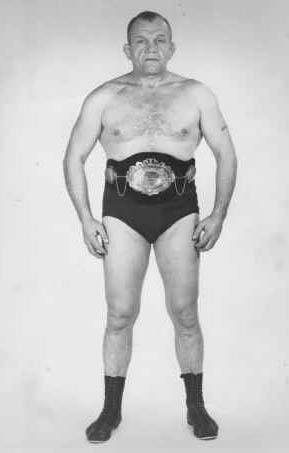
Bulldog Lee Henning.
Whether he was known as Bulldog or Butcher Boy, his imposing ring demeanor ensured that the veteran grappler was never without work for long, in an era when pro wrestlers spent as much time on the road as they did in a wrestling ring.
Lee Wilbur Henning was born on a farm in Iowa in 1920 and had his first taste of wrestling in high school where he also played football. It was only natural that the young farm boy would excel at contact sports since at age 16, he stood 6-foot-1 and weighed 251 pounds.
Farm life is never easy at the best of times and when he grew up on a farm in the 1920s and 1930s, Henning learned some of life’s lessons the hard way. He once told a writer for the Kitchener Record that he never had any formal training to become a wrestler.
“I guess you could say the farm was my training ground,” Henning confided to the newspaper’s Bill Johns in 1974. “There was always lots of work to do on the farm to build up a boy. In those days you worked from daylight to dark. I didn’t know any other way of life. It was hard.”
But there were also important lessons to learn from farm life and Lee never forgot the learning process he went through in his youth.
“I remember reading somewhere that love comes from misery. If there is no misery in a person’s life, there can be no love,” he recalled. “We didn’t get everything we asked for in those days. I recall once when I asked my father for some ice skates. He said he would buy me a pair but I had to cut an acre of standing wood. It took me a long time but I did and I got those skates. They were among my most prized possessions.”
One of the most significant rules he lived by was that there was no way you could make money without working. At age 19, the Iowa farm boy traded his coveralls for a pair of wrestling trunks and became a wrestler. For a short time he worked on a circuit in the U.S. mid-West. He gradually broadened his horizons and moved into upstate New York and the Southern Ontario circuit.
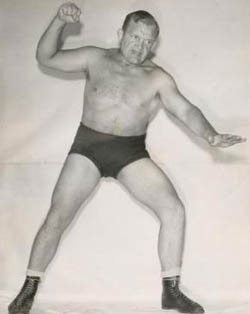
Big, rough and gruff, it didn’t take Henning long to get noticed at the outset. The Pittsburgh Post Gazette heralded his first trip East with this buildup: “Lee Henning, the newest wrestling sensation from the Farmer Burns school of matology in the heart of Iowa towers six feet four inches and weighs 230 pounds.”
There was always a disparity in a wrestler’s height and weight depending on the generosity or conservative nature of the reporters. But there was no denying that Henning was an imposing figure and he didn’t shy away from mixing it up with the likes of Ed “Strangler” Lewis, Everette Marshall or Ivan Rasputin.
He quickly earned the tag of “Butcher Boy” and with his villainy was a prime target for a special referee like former heavyweight boxing champion Jack Dempsey to cut him down to size on occasion. Henning was all over the map and the mat in his first decade of deviousness and in 1950 had a particularly impressive run in Wichita, Kansas. He scored wins over worthy opponents such as Vic Holbrook, Bobby Bruns, Vic Christy, Sonny Myers and Seelie Samara. But the belt eluded him when he was disqualified in a match against NWA champion Lou Thesz in a title bout.
Perhaps, Henning found his niche in Toronto where he became associated with promoter Frank Tunney and found steady work on the weekly cards at Maple Leaf Gardens. He had the distinction of being the first opponent of Whipper Billy Watson at MLG in 1940, albeit in a losing cause. A few years later, Watson got a push and became a Canadian wrestling legend.
Henning had made the move to the area, settling in Buffalo, N.Y. but before his bookings with Tunney would increase, he joined the U.S. Army in 1942 where he rose to the rank of staff sergeant and spent four years in the Pacific war zone.
“I was in the engineering corps and was a miserable bastard during the war,” he once confided to a reporter. “But that’s the way the Army wanted you. I didn’t see first line combat but if it wasn’t for us, neither would the infantry. The engineers made the way for the infantry so you couldn’t say we missed much of the action.”
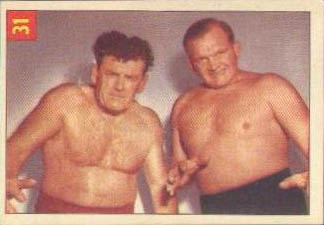
Fred Atkins and Lee Henning from the Parkhurst wrestling card set of 1955.
One of his most unusual matches was during the war while stationed in New Guinea. He was challenged by members in another army unit to wrestle someone he recalls only as Big John. Henning explained that he wasn’t in shape to fight anyone since he had not worked out in a long time.
But when an officer informed him that a large shipment of steak was arriving and that he could get ready by eating as much steak as he wanted, Henning was sold on the idea.
“It got to be quite a big deal and a lot of money was bet on the outcome because the guys didn’t have anything else to spend their money on.” He remembered. “I ate a lot of steak both before and after the bout. I beat the guy in 17 seconds. It was the only time I wrestled for steak.”
But after the war, Henning returned to pro wrestling in earnest, working all over the States and Canada for serious money. He also traveled to New Zealand, Australia, China, the Philippines and Japan. He met all the big names in the business and recalled Thesz, Strangler Lewis and Sandor Szabo as the three best he ever fought. When he was in demand, he worked four and five times a week, summer and winter.
The hardware he wore around his waist was a testimony of his value to promoters. Most notably he held the NWA Central States Heavyweight Championship on six occasions in the early 1960s while working in St. Joseph, Missouri. He and partner Tom Rice also held the Los Angeles based WWA International Television Tag Team Championship in 1956 meeting strong teams such as Don Leo Jonathan and Lord Carlton. In St. Louis, he often appeared on the same card as John Paul Henning and promoters were quick to point out that the pair was not related. There were few similarities, particularly ring style, between the farm boy from Iowa and the Florida frogman.
While Henning’s early career was often as a headliner, promoters eventually typecast him as a jobber, one of the steady, reliable old fall guys who paved the way for younger stars of the mat. Like many of the seasoned villains of the time, Henning always had a hidden object in his trunks, a fact known to everyone in the arena but the referee. Along the way, he picked up the nickname “Bulldog” in recognition of his tenacious and tough ring demeanor.
Whipper Watson held Henning in high esteem and once paid him the ultimate compliment: “He was good. We used to think of Lee as a good tester for young wrestlers. If they could hold their own with Lee, then they could make it in the sport.”
But there was much more to the globe-trotting Bulldog than his shenanigans in the ring. He was married to the same woman for over thirty years and while the couple was childless, he took his wife Irene on many of his road trips and out of the country. He was of the opinion that it was the only way a marriage could work when there was so much traveling involved.
A professional wrestler for over three decades, his longevity in the physically demanding role of pro wrestler was remarkable. Like most wrestlers, he suffered a multitude of injuries over the years, the most serious being kidney problems that once kept him out of action for eight months. He liked to say that the game was “a hard way to make an easy living.”
If Henning had any regrets in his athletic life it was that he never seriously pursued his true love which was golfing. He apparently got the bug for the links in the late 1940s and early 1950s while working in California. He considered himself a scratch golfer and believed that if he wasn’t a pro wrestler he would have been a pro golfer.
But he was very much the typical, grizzled old mat man of the period and according to the Hamilton Spectator “he was a big man with a deeply lined face with ears that looked like well-chewed plugs of tobacco.”
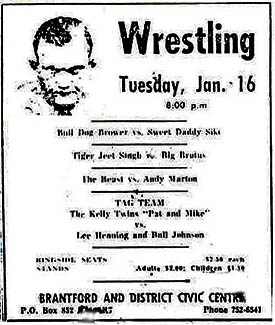
Henning became a fixture at Toronto’s MLG and his presence on the weekly cards ensured some lively and entertaining moments. He was also a regular in other Ontario centers and was well known in Hamilton, Kitchener and London. Fans looked forward to the Bulldog’s appearances and his antics in the ring. In the second half of his career, he was resigned to working preliminaries and suffered more losses (many by disqualification) than wins but there were also draws to lend some measure of respectability to his skills.
Henning joined a supporting cast of Tunney regulars that included Fred Atkins, Pat Flanagan and Tiger Tasker in putting over the stars. But according to Andrew Calvert, an authority on the Toronto wrestling scene with his Maple Leaf Wrestling – Pictorial website, Henning figured into some prominent matches during his MLG stint.
“In 1971, he provided the opposition for Jean Ferre (Andre the Giant) in the giant’s first appearance at the Gardens. Other Henning opponents were Don Leo Jonathan, a young Gino Marella (Gorilla Monsoon), Johnny Valentine, Bobo Brazil, and Giant Baba. He also teamed with most of the regulars, including Wildman Dave McKigney,” noted Calvert.
Henning was involved in many gimmick bouts including a feud with a local grappler named Shilelagh O’Sullivan, an Ajax construction worker. The Irishman’s main claim to fame was that he was managed by columnist Paul Rimstead of the Toronto Sun. The Rimmer was the most popular newsman in Toronto at the time and his presence in the storyline ensured much publicity and fan interest.
Calvert pegs June 6, 1975 as Henning’s last match at MLG when he appeared in a mixed tag match with midget Dirty Morgan to oppose Mike Loren and Bobo Johnson.
Writer Earle Yetter introduced wrestling fans to a new dimension of Henning in an article appearing in Wrestling Monthly in 1975.
“Lee ‘Bulldog’ Henning could have been a great comedian instead of a wrestler,” claimed Yetter. “He is a stand-up monologist of the first water and he uses some of his intrigue during his matches just to confuse his foes. At a party he can regale those present with humorous stories and satires on some of the incidents that have happened to him during his matches.”
It was Yetter who labeled the Bulldog as the “Man of 1000 Faces.”
“He has the infinite quality of coming up with comical didoes during the heat of a match to reduce the tension he is under,” wrote Yetter. “At 245 pounds, Henning has the appearance of a blown-up version of Joe Palooka.”
Such was the appeal in and out of the ring of the young farm boy who came out of the fields of Iowa to achieve manhood in the wrestling rings of the world. The long journey ended in Crystal Beach, Ontario, in 1977 when Lee Henning passed away.
But the wily veteran didn’t run out of road until he ensured his place in mat history was secure. He was a villain of the first order to the fans who paid to see him. If he had the traits of a bulldog, it was only his tenacity and determination that earned him that nickname. Away from the squared circle, he was a gentle giant to those who were close to him.
True to his name, the Bulldog has firmly left his mark wherever he performed.
